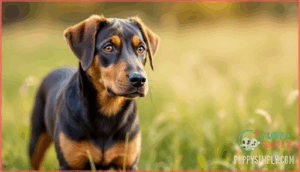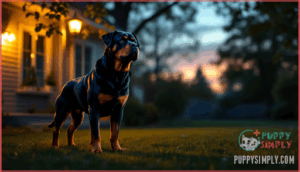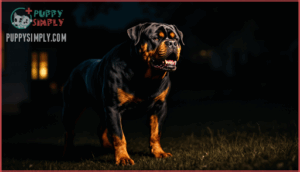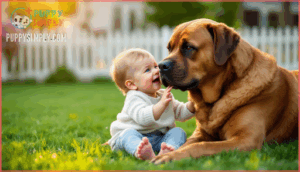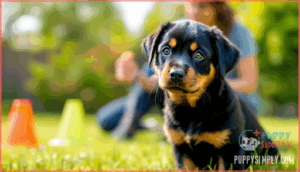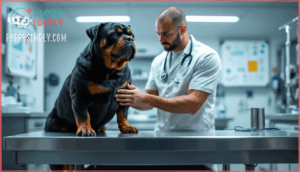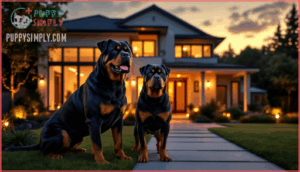This site is supported by our readers. We may earn a commission, at no cost to you, if you purchase through links.

But owning a Rottweiler as a guard dog isn’t as simple as bringing home a puppy and watching them transform into your family’s protector. Their protective nature requires deliberate training, early socialization, and an owner who understands the difference between a well-adjusted guardian and a liability.
Whether you’re considering a Rottweiler for home security or already own one, understanding what shapes their guard dog capabilities—from their temperament to health needs—determines whether you’ll have a confident protector or a reactive risk.
Table Of Contents
- Key Takeaways
- Rottweiler Guard Dog Traits
- Rottweilers as Family Protectors
- Essential Rottweiler Training Tips
- Health and Care Considerations
- Choosing and Owning a Rottweiler Guard Dog
- Frequently Asked Questions (FAQs)
- How much exercise does a Rottweiler need?
- What health issues are common in Rottweilers?
- How can I best socialize my Rottweiler puppy?
- What kind of fence and enclosure should I have for a Rottweiler?
- What commands are most important to teach a Rottweiler guard dog?
- How do Rottweilers compare to other guard breeds?
- What are insurance implications for Rottweiler ownership?
- Can Rottweilers adapt to apartment living conditions?
- How much does a quality Rottweiler puppy cost?
- What equipment is essential for Rottweiler guard training?
- Conclusion
Key Takeaways
- Rottweilers require deliberate training and early socialization to transform their natural protective instincts into controlled judgment rather than reactive aggression, making the owner’s commitment the determining factor between a reliable guardian and a dangerous liability.
- These dogs excel at threat assessment through a "wait and assess" approach rather than impulsive reactions, combining their intimidating physical presence (80-135 pounds) with intelligence to deter intruders before physical confrontation becomes necessary.
- Professional guard dog training costs $3,000-$4,000 for 4-6 week programs and produces measurable results, with properly trained Rottweilers responding accurately to threats 90% of the time while force-free methods build trust without creating fear-based aggression.
- Rottweilers face significant health challenges including a shortened lifespan of 8-10.6 years, with cancer claiming over 45% of deaths and hip/elbow dysplasia affecting up to 20-38% of the breed, requiring substantial veterinary care investment alongside breed-specific legislation and insurance complications that can cost $100,000-$500,000 in required liability coverage.
Rottweiler Guard Dog Traits
When you’re looking at Rottweilers as potential guard dogs, certain traits stand out immediately. Their physical build, natural instincts, and commanding presence all work together to make them formidable protectors.
Let’s break down the specific characteristics that define a Rottweiler’s guarding capabilities.
Physical Characteristics and Size
Standing between 22 and 27 inches at the shoulder and tipping the scales at 80 to 135 pounds, a full-grown Rottweiler draws stares the moment it enters a room. Males often exceed 100 pounds, giving them the physical strength to back up their guardian role.
Their muscular build and large head create an intimidating presence that keeps intruders at bay. That black coat requires minimal maintenance while helping them blend into shadows at night—a natural advantage for property protection.
Protective Instincts and Temperament
Physical presence is only half the equation. What truly makes Rottweilers stand out as guard dogs is their deep-rooted protective instincts. These dogs possess natural vigilance inherited from Roman-era cattle guardians. They display breed aloofness toward strangers while maintaining fierce family loyalty.
Rottweilers usually employ a "wait and assess" approach rather than reacting impulsively. Their guarding abilities shine when distinguishing genuine threats from routine occurrences, though proper training greatly impacts how these protective instincts manifest in real-world situations.
These dogs are also known for their high intelligence levels, making them quick learners.
Intimidating Presence and Bark
Beyond sheer muscle and instinct, a Rottweiler’s bark and physical presence work like an invisible fence—most intruders never make it past the front yard. Their deep bark resonates with authority, serving as a powerful vocal deterrent before any physical confrontation occurs.
Combined with their intimidating black coat—perfect camouflage at night—Rottweilers create a fear factor that stops threats cold. Appearance matters in guard dog work, and this natural protection often prevents incidents rather than confronting them.
Rottweilers as Family Protectors
Rottweilers don’t just guard property—they form deep bonds with their families and become natural protectors of the people they love. Their loyalty runs deeper than most breeds, making them remarkable at watching over homes and loved ones.
Here’s what you need to know about how Rottweilers interact with family members, treat children, and assess who belongs and who doesn’t.
Loyalty to Family Members
When you bring a Rottweiler into your home, you’re not just getting a guard dog—you’re gaining a fiercely devoted companion who’ll stand between your family and any threat without hesitation. This loyalty runs deep, transforming your Rottweiler into a vigilant family watchdog with protective instincts that never sleep.
A Rottweiler isn’t just a guard dog—it’s a fiercely devoted companion who’ll stand between your family and any threat without hesitation
Their bond strength manifests through:
- Constant monitoring of family members’ whereabouts and safety
- Affection display through gentle leaning and close proximity
- Alert responses to unusual sounds or approaching strangers
- Natural family protection behaviors without aggressive training
- Unwavering commitment to child companionship and supervision
These loyal guardians don’t just protect—they become emotionally invested in your household’s well-being.
Interactions With Children
The American Kennel Club rates Rottweilers as "extremely affectionate with family" but only "moderately good" with young children—a distinction you can’t ignore when considering breed suitability as family pets. Your Rottweiler’s massive frame (up to 135 pounds) demands constant play supervision to prevent accidental knockdowns during roughhousing. Rottweilers can be great family pets, provided they receive proper training and socialization.
These family-friendly dogs thrive when you establish clear boundaries through positive reinforcement training. Despite their historical reputation as nanny dogs, child safety depends entirely on your commitment to professional training and consistent discipline—creating the family pet relationship you’re seeking.
| Safety Factor | Your Action Plan |
|---|---|
| Physical Size Risk | Never leave toddlers unsupervised; adult oversight required |
| Overprotection Tendency | Early socialization prevents misinterpreting child play as threats |
| Accidental Injuries | Teach "time-out" methods; structure short, calm play sessions |
| Mutual Respect | Training children in dog safety rules (no tail-pulling) builds respectful interactions |
Differentiating Friends From Threats
Your Rottweiler’s ability to sort the good guys from the bad isn’t born from instinct alone—it’s a skill you’ll actively shape through deliberate training and consistent exposure. Reading body language and recognizing danger signals improve when you:
- Practice controlled aggression exercises with professionals
- Reward calm protective behavior during supervised introductions
- Expose your guard dog to diverse situations early
Socialization importance outweighs raw guarding instincts—training transforms territorial behavior into reliable judgment.
Essential Rottweiler Training Tips
Training a Rottweiler to be both protective and well-behaved isn’t something you can leave to chance. You’ll need a game plan that starts early and stays consistent throughout your dog’s life.
Here’s what you need to focus on to raise a Rottweiler guard dog you can trust.
Early Socialization Techniques
Think of early socialization as building a library of positive experiences—each new encounter teaches your Rottweiler puppy how to confidently navigate the world without overreacting to unfamiliar situations.
Between 3 and 14 weeks, you’ll want to introduce your pup to different people, sounds, surfaces, and environments. This critical socialization period shapes breed-specific needs, transforming guarding instincts into controlled watchfulness through positive reinforcement rather than fear-based reactions.
Force-Free Training Methods
Force-free training transforms your Rottweiler’s natural strength into disciplined protection without breaking the trust that makes them remarkable guardians. Positive reinforcement and clicker training establish obedience training foundations that last a lifetime.
Effective reward systems for guard dog training include:
- Treats immediately after correct responses
- Verbal praise paired with physical affection
- Play sessions as high-value rewards
- Consistent timing to reinforce desired behaviors
Avoiding punishment prevents fear-based aggression, while building trust strengthens your Rottweiler’s confidence and judgment.
Professional Guard Dog Training
Certification standards from organizations like the International Association of Canine Professionals guarantee your Rottweiler guard dog characteristics meet professional benchmarks. Legal requirements vary by jurisdiction, but many municipalities mandate professional training for protection work.
Effective guard dog training spans 4-6 weeks, with board-and-train programs costing $3,000-$4,000. Canine training produces measurable outcomes—over 85% of dogs show improved obedience, and properly trained Rottweilers respond accurately to threats 90% of the time.
Health and Care Considerations
Your Rottweiler’s imposing presence comes with serious health responsibilities you can’t ignore. These powerful guardians face specific medical challenges that directly impact their effectiveness as protectors and their quality of life.
Let’s examine what you need to know to keep your guard dog in peak condition.
Common Health Issues in Rottweilers
While owning a Rottweiler means welcoming a loyal guardian, it also means preparing for breed-specific health challenges. Hip dysplasia affects roughly 22% of Rotties, while elbow dysplasia strikes nearly 39%—considerably higher than many breeds.
Cardiac screening helps detect subaortic stenosis early, and GDV prevention strategies are critical given their deep-chested build.
Cancer risks loom large, claiming over 45% of Rottweilers. Skin ailments, including ear infections and hot spots, affect about 11% of dogs, making regular vet visits essential for your Rottweiler’s health and lifespan.
Exercise and Diet Requirements
A Rottweiler’s muscular frame needs proper fuel and movement to stay healthy—and to keep those genetic health risks at bay. Here’s what your guard dog needs:
- Daily exercise: 60-90 minutes of vigorous activity prevents obesity and joint stress
- High-protein diet: Quality nutrition aids muscle mass and immune function
- Portion control: Rottweilers gain weight easily; measure meals carefully
- Fresh water access: Hydration importance can’t be overstated for active dogs
- Mental stimulation: Training sessions satisfy exercise needs while sharpening instincts
Lifespan and Veterinary Care
Even with proper exercise and nutrition, Rottweilers face a shorter lifespan than many dog owners expect—usually 8 to 10.6 years compared to the average purebred’s 12.7 years. Cancer predisposition accounts for over 45% of deaths in this breed, while hip dysplasia and elbow dysplasia affect up to 20% and 38% respectively.
Regular veterinary care catches obesity risks early and provides preventative care that can extend your dog’s healthiest years.
Choosing and Owning a Rottweiler Guard Dog
Bringing a Rottweiler into your home isn’t a decision to take lightly. You’ll need to evaluate your living situation, commit to responsible ownership, and understand the legal landscape surrounding this powerful breed.
Let’s walk through what you need to evaluate before welcoming one of these loyal protectors into your life.
Assessing Suitability for Your Home
Before bringing a Rottweiler into your life, you need to honestly evaluate whether your living situation, lifestyle, and experience level can meet this breed’s substantial demands. This protective breed thrives when their environment aligns with their guarding abilities and exercise needs.
Consider these factors:
- Space Requirements: Rottweilers need room to move—apartment living can work, but houses with secure yards better support their home security instincts
- Experience Level: First-time owners may struggle; these dogs demand confident leadership to channel their family watchdog traits appropriately
- Lifestyle Compatibility: If you’re rarely home, this guard dog will suffer—Rottweilers require daily interaction and mental stimulation
- Family Dynamics: Young children and a powerful protective breed need careful assessment of everyone’s commitment level
Responsible Ownership Practices
Once you’ve matched your home to your Rottweiler’s needs, the real work begins—responsible ownership isn’t just about what you provide, but how you manage the powerful guardian you’ve welcomed into your world.
| Responsibility | Action Required |
|---|---|
| Ethical breeding | Source from temperament testing breeders who prioritize health over profit |
| Owner education | Commit to ongoing Rottweiler training and socialization throughout their life |
| Legal liabilities | Secure liability insurance and understand breed-specific legislation in your area |
| Dog aggression prevention | Monitor interactions and address warning signs immediately with professional help |
| Breed advocacy | Demonstrate responsible Rottweiler ownership through your dog’s behavior and your dog ownership responsibilities |
Your Rottweiler represents both you and the breed—every interaction shapes public perception.
Addressing Breed Reputation and Legal Concerns
Your Rottweiler’s future hinges on understanding breed-specific legislation and public perception challenges before you sign adoption papers. Here’s what you’re up against:
- Breed-Specific Legislation: At least 12 countries ban Rottweilers outright, while 16 EU states restrict ownership through insurance mandates and containment rules.
- Insurance Exclusions: Most U.S. homeowner policies exclude Rottweiler liability coverage—specialized protection costs $100,000-$500,000 in required limits.
- Municipal Restrictions: Cities like Clinton, Mississippi and Walkerton, Indiana maintain local Rottweiler prohibitions despite no statewide bans.
- Reputation Rehabilitation: Despite 9.8% of fatal bite incidents (2005-2019), responsible ownership and training transform public perception more than genetics ever could.
- Legal Consequences: Failing to maintain required coverage triggers substantial fines or ownership forfeiture in restricted jurisdictions.
Your commitment to responsible ownership doesn’t just protect your family—it reshapes how the world views this misunderstood breed.
Frequently Asked Questions (FAQs)
How much exercise does a Rottweiler need?
Strong Rottweilers require rigorous daily exercise—at least 60-90 minutes of active movement. Without mental stimulation and physical activity, these powerful dogs risk obesity and behavioral issues.
Puppy exercise needs gradual building, while senior Rottweilers benefit from gentler routines to protect aging joints.
What health issues are common in Rottweilers?
Rottweilers face significant health challenges you can’t ignore. Hip Dysplasia affects up to 20% of the breed, while Elbow Dysplasia strikes 38% — both crippling joint conditions.
Cancer Predisposition is their leading killer, causing over 45% of deaths. Obesity Risks compound these issues without proper dog care and veterinary care monitoring.
How can I best socialize my Rottweiler puppy?
Start socializing your Rottweiler during puppyhood through controlled environments like puppy classes. Early exposure to various people, animals, and situations using positive reinforcement builds confidence.
Breed-specific socialization helps your dog develop proper judgment, distinguishing friends from threats effectively.
What kind of fence and enclosure should I have for a Rottweiler?
Your fence should be at least six feet tall—ideally solid wood or vinyl—to prevent territorial guard dog behaviors from triggering at passersby.
Bury mesh or concrete footers 12-18 inches deep for digging prevention. Secure gates with double-latching mechanisms, and verify your enclosure size meets local regulations.
What commands are most important to teach a Rottweiler guard dog?
Teaching basic obedience training commands like "sit," "stay," and the recall command forms your foundation.
Add protection cues for boundary setting and threat assessment once your Rottweiler masters these essentials through consistent guard dog training sessions.
How do Rottweilers compare to other guard breeds?
Compared to German Shepherds and Doberman Pinschers, Rottweilers excel in sheer intimidation and breed size, while Dobermans offer speed and German Shepherds provide adaptability in training needs and protection styles across different guard dog breeds.
What are insurance implications for Rottweiler ownership?
Many insurers restrict coverage for guard dog breeds through Policy Exclusions or increased Liability Coverage Costs. Rottweilers frequently appear on restricted lists alongside pit bulls and Dobermans, triggering Breed-Specific Legislation concerns and elevated dog ownership responsibilities.
Can Rottweilers adapt to apartment living conditions?
While it’s possible, apartment living presents real challenges for this breed. Rottweilers need substantial exercise and mental stimulation daily—not just quick walks.
Noise levels from their deep bark may violate apartment rules, and their space requirements demand more than cramped quarters.
How much does a quality Rottweiler puppy cost?
You’d think spending more means guaranteed protection, but choosing a Rottweiler puppy isn’t that simple.
Good breeders generally charge $1,000-$3,500 for quality Rottweilers, with show potential pups reaching $7,000+ . Breeder reputation and health testing directly impact pricing.
What equipment is essential for Rottweiler guard training?
You’ll need basic equipment for effective guard dog training: a sturdy training leash for control during dog commands practice, a quality bite sleeve for protection work, and a reliable reward system using treats or toys to reinforce positive dog behavior.
Conclusion
Choosing a Rottweiler guard dog is like forging a blade—raw potential means nothing without proper tempering. Everything you need to know about guard dog Rottweiler ownership boils down to commitment: consistent training transforms their protective instincts into controlled vigilance, while neglect creates unpredictable aggression. Your Rottweiler won’t become a reliable guardian by accident.
Invest in socialization, understand their health vulnerabilities, and respect the responsibility that comes with owning a breed capable of both profound loyalty and serious harm. The difference between protector and problem lies entirely in your hands.

